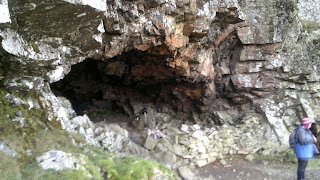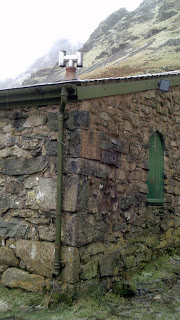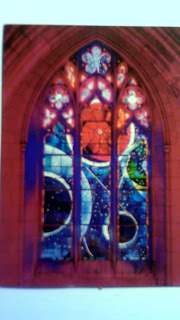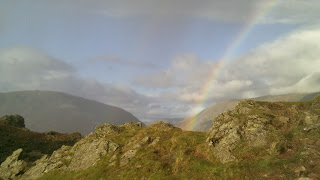Saturday, 30 November 2013
The end of the Moon
Never mind Comet Ison, the Moon has almost gone! Well, for this month at least. The Moon has nearly finished its monthly journey around the Earth. This picture was taken at 8am looking almost due South. In other words, it is highest in the sky at perhaps 9am. If it takes 27 days to go round the Earth, this high point in the South must be about an hour later every day. That means in 3 days time the Moon will be due South at around midday. It will be on the same side of the Earth as the Sun. The Sun will be lighting up the side that we can't see and the side facing us will be in shadow. In other words, in a couple of days we won't be able to see the Moon at all. Then after that there will be a faint sliver of a crescent on the right hand side this time - a New Moon. If the sky is clear I'll try to photograph it!
Thursday, 28 November 2013
Cows need water
We were out on Hadrian's Wall the other month and found this water trough for cows. Our house doesn't have a water tank like this in the loft because the advent of the combi-boiler has removed the need for a hot water tank. But the ballcock is a fabulous invention. The plastic ball is less dense than water so it floats. The upthrust force on it pushes it up against the valve in the pipe, closing the valve. As the water level drops, the floating ball drops with it. Eventually there is so little upwards force on the valve that water pushed through to fill the tank. The floating ball rises to close the valve and cut off the water. An example of feedback!
Wednesday, 27 November 2013
An piece of art about waves
We went to Tullie House on Monday to see the Roman helmet but we also found a brilliant work of art. They would let me photograph it so you'll have to make do with a photograph of the leaflet. Alternatively you can go to http://www.artfund.org/what-we-do/art-weve-helped-buy/artwork/11956/ocean
It is about 1000 small ceramic pots laid out to be like a wave on the ocean. Waves are a transient thing. They are hard to pin down. Do you draw a graph of them frozen in one moment in time or draw a graph of how a single point on the wave moves with time? I suppose Natasha Daintry has chosen the former. I like its simplicity. I should have measured the wavelength. The amplitude decreases. What would we give for the wave speed? The exhibition is in Carlisle until March - plenty of time to go to see it.
Tuesday, 26 November 2013
DNA security at the substation
Substations are very dangerous but we were intrigued by the DNA sign. The yellow sign is obvious. Will need to find out about the DNA security system.
Monday, 25 November 2013
Kelvin Wake on Walla Crag
I always like climbing up above Derwent Water because you can look down on the wave patterns. Yesterday we were looking down from Walla Crag when the passenger boat came past. If you enlarge the photograph you can see the characteristic wave pattern behind the boat. It is called a Kelvin Wake after Lord Kelvin the Scottish physicist who first did the analysis. I haven't had time to read the mathematics in detail - I'll need to get back to you - but it seems that the angle may be just over 19 degrees whatever speed in deep water. I need to check this claim. I got my information from http://www.wikiwaves.org/Ship_Kelvin_Wake
When we were on the summit another bloke pointed out the marking in the rocks shown below. He said he thought it was a benchmark, which was a topic on this blog in September. I have checked the benchmark listing website and it's not recorded, so the jury is out. It doesn't look natural but it is flat, not vertical. It has no top line.
Sunday, 24 November 2013
Red like a Spindle Tree
We found a Spindle Tree at Watchtree Nature Reserve. We surprised to find one so far north. Note the lovely red flowers. I teach that things are red because they reflect red but absorb the other colours of the spectrum that fall on them. The combination of the colours makes up white light. Quantum theory leads to some uncomfortable thinking for me. What do I mean by absorb? I'd normally mean that the photon energy matches an electron energy level jump so an electron jumps up. But that's what happens with the red. Then the electron falls and re-emits a red photon as far as I understand it. I'd say that the other photons are ignored by the atom as their energies don't match electron level jumps. So where do they go? They don't go though the object or else it would seem somewhat translucent. This needs working on.
Saturday, 23 November 2013
Measuring the flow in Wigton
They put a depth measurement scale into the Wiza by the factory in the summer.
This followed the disastrous flood one Saturday afternoon in May. Here's what Station Road looked like. And, yes, that is someone canoeing down the road.
The study of fluid flow has its place in Physics. I hope someone will be able to find a solution. Perhaps data from the new pole will help.
The issue is flow rate. This means how fast the volume of water is shifted so it will be measured in cubic metres per second. At this point in Wigton, the Wiza is constrained in a narrow but deep channel. Water cannot be compressed into a smaller volume. In a liquid, the atoms are basically touching each other. If the new shape of the channel doesn't have a big enough volume for the water pouring into it there will be flooding. One way round the problem is to get the water flowing faster, or to pour the water in slower at the start. The other problem is that the water has a tight corner to turn at the factory so momentum will tend to make it carry straight on and out onto the road by the fire station.
Thursday, 21 November 2013
Lower Sixth Estimation Question #3
Here are 2 pictures of a radiant heater showing it before and after it is turned on. It is made of 2 heating elements that are wired in parallel. Each element is rated at 1kW. It is connected to mains voltage. If you click on the top picture to enlarge it, you'll see that each element is made of reasonably thick wire wound around a cylinder. Ignore the central cylinder - it's the wire that spirals around it that carries the current and heats up.
I want you to
- Calculate the resistance of one of the heating elements.
- Estimate the length and cross-sectional area of one spiral of heating wire.
- Calculate the resistivity of the wire.
- See if you can find a metal with that resistivity.
Tuesday, 19 November 2013
Biomass
We found this sign on the door of a hotel shed in the Lake District. Biomass is a word that seems to have changed its meaning.
Biomass has a strict meaning in Biology. It is the mass of the living tissue in an organism. Water isn't alive so it can't be counted. When you stand on the scales you are weighing both your biomass and the mass of water. To find your true biomass we'd have to dry you out in an oven before weighing you. In Biology the movement of biomass in a food chain is important. The higher up the food chain the lower the total biomass because some is lost by living.
But biomass is now often used for fuel that has come from living things as opposed to fossil fuels. It seems to me that this shed is really just a wood store with a fancy name!
Monday, 18 November 2013
On the front line in Silloth
We drove through rain from Wigton to Silloth to have our lunch. The sky was just clearing over the sea as we arrived. Looking south west along the coast there was this long bank of cloud. According to the weather maps it's a cold front. At our latitude, cold air front the Arctic runs into warm air from the Equator. The air masses don't easily mix to give medium temperature air. Where a block of warm air meets a block of cold air you get a weather front. What happens is that as the cold air moves into the back of a mass of warm air, the warm air moves up because it is less dense. A wedge of more dense cold air moves in underneath it. There is more water vapour dissolved in the warm air but as that air rises it cools down. The water vapour can't be held invisible in the air anymore so it condenses out to form clouds. So the boundary between warm and cold air is marked by a line of cloud. These were first drawn on weather maps just after the First World War. They looked like maps of the Western Front battle lines, so they became called weather fronts. It takes about 6 to 8 hours for a frontal system to clear the UK, hence my dad's old weather saying: Rain before 7, fine before 11.
Looking north east. The weather front curls away to the right.
Looking over to Criffel in Scotland. This is looking into the cold air mass. There is less convection to distort the visibility in cold air so the view was very clear.
Sunday, 17 November 2013
A real radiant heater
I couldn't resist photographing this radiant heater. This type of heater was always used as an example in Physics text books. The bright bits are tightly wound coils of thick wire. They must have high resistance because the current heats the wire until it glows at the red end of the spectrum. As well as the visible light, a lot of infra-red must also be released. It is reflected in our direction by the concave silver backing. Silver is a bad absorber of infra-red. These heaters are great because they heat a room most quickly. The infra-red travels at the speed of light. The other issue is that the metal case would conduct electricity in the event of a fault. Thus there is an earth wire soldered onto the case to conduct away stray electric current and blow the fuse. The case can't be made of insulating plastic because it would melt.
Saturday, 16 November 2013
Finding fault near the Priest's Hole
We climbed up to the Priest's Hole, a rock shelter high on Dove Crag. Some people sleep there and it even has its own log book to record your visit.
Caves in the Lake District cannot be like those in limestone areas that are due to acidic water wearing the rock away. This is because the rocks are volcanic. I suspect this enlarged overhang is probably the result of ancient earth movements - ie a fault. The cave is situated near the top of the crag just left of centre in the picture below. If you enlarge it you can probably make out a diagonal grass shelf sloping from left to right. This is evidence of a fault.
We found this amazing boulder nearby. The ash layers in the tuff are clearly visible.
Look at the small scale fault in the rock. It has only slipped a few centimetres.
Friday, 15 November 2013
Tuff going on Scafell Pike
Scafell Pike is made of volcanic rock as is the majority of the central part of the Lake District. Sedimentary rock is well known for forming layers as the pieces of eroded rock and sand sink to the bottom of the sea. But there are layered effects in volcanic rocks as well. Ash and volcanic bombs are fired up into the air and settle under the influence of gravity. These are the layers shown and the rock type is called a tuff. I'd be interested to know how much the wind affects the settling of the layers. You can see that there are twists in it. Then note that the layers are vertical. Think of the forces in the crust of the Earth that must have been necessary to make horizontal rock go vertical.
Thursday, 14 November 2013
An Lochan Uaine
Whilst we were in Aviemore we visited the Green Lochan, An Lochan Uaine in Gaelic. Look at the photograph - the water really does look green. I've been trying to find out why. I'd guess that copper had leached into the water. The malachite ore of copper is green. Copper chloride is green, but it also poisonous so that can't be the reason. I've been looking for answers on the net. Some sources say that glacial lakes are green because of the way particles suspended in the water scatter light but the last time there was a glacier here would have been over 10000 years ago. So a mystery at the moment. The lochan gets a mention in this poem on the back of the door of the nearby Ryvoan bothy where you can sleep on the floor for free (bring your own fire wood)
We were interested because it was written by a woman from Burgh by Sands near Wigton, although they get the name of the village wrong in the bothy copy!
Wednesday, 13 November 2013
A log burner
Here's another source of heat. The idea is that the combustion reaction of the burning logs heats up the metal case. The case is painted black because it then emits infra-red heat radiation into the room. I prefer radiant heat to convection. It travels at the speed of light (it is infra-red light) and so it instantly feels hot. It takes longer for my convection heater to circulate thermal energy by means of density changes in the air. But note that although it true that matt black surfaces absorb heat radiation well, the opposite is going on here. A matt black surface is emitting heat radiation well.
Tuesday, 12 November 2013
My convection heater
Here is a photograph of my electric convection heater. Notice that it is painted white because it doesn't give off heat as infra-red. As its name implies, it gives off heat by convection.
Here is a photograph of the bottom of it looking up. The black bits are an electrical heating element which was running at 1200W when the photograph was taken. The element is at the bottom because it heats the air. The air expands and becomes less dense than the colder air around it so it floats up through the grill at the top of the heater. You mustn't cover those holes at the top because the hot air would be trapped inside and the unit would overheat and perhaps start a fire.
Monday, 11 November 2013
Brian Cox does Dr Who
Just advance warning that Brian Cox is doing an hour on "The Science of Dr Who" on Thursday night on BBC2 at 9pm. Going to be a lot on time travel I think!
Solar panel in the mountains
Here's the scene in Grisedale near Patterdale on Saturday morning BEFORE the blizzard! Ruthwaite Lodge is a climbing hut that's just above the trees mid-left in this view.
It was snowing by the time we reached it. It was locked but I noticed the solar panel.
I'd estimate the dimensions as 20cm x 15cm, so an area of 0.03 square metres. The intensity of sunlight is given as 1400 Watts per square metre. This would suggest 42 Watts for this panel. However 1400 would be for light hitting the Equator full on, so it will be less here as we are facing the Sun at an acute angle in winter. We have also to allow for the efficiency of the panel in turning sunlight into electrical energy. I found this graph http://en.wikipedia.org/wiki/File:PVeff(rev131111)a.jpg So say we estimate a 30% efficiency, we'll not be getting much over 10 Watts out of this panel on a sunny day. I wonder what it does?
Sunday, 10 November 2013
Reflecting on Rock Night
It was Rock Night on Friday night. If you weren't there, you missed another great performance by the staff band with our new lead singer. (I've never been known to be modest) There were a lot of other great performances too. Lots of Physics to look at but I chose this lighting unit at the back. It has a rotating drum with rectangular flat sections of plane mirror on them. The rule for reflection is that the angle of incidence = angle of reflection. The angles are measured to the normal line, an imaginary line sticking out of the surface of the mirror at 90 degrees. As the mirror rotates, the angle of incidence varies which changes the angle if reflection so the reflection of the light moves. Then the light will jump to the next mirror section. Next time I need to look more carefully at what exactly happens when it jumps from one mirror section to the next.
Wednesday, 6 November 2013
Why wool is good insulation
Here are some well insulated locals on Hadrian's Wall. Mammals have some form of fur covering. The fibres trap air between them. Since the air is trapped, it cannot carry heat away by convection even though it will expand and become less dense. The hair also stops the wind moving particles away from the surface of the skin so it also reduces evaporative cooling. Hence the air trapped by the sheep's wool is a good insulator. It is a gas so and the particles are not joined so it is bad at conduction. The trapped air will be a bit cooler than the body but a bit warmer than the air around. It means that the temperature doesn't fall as quickly when you move away from the skin which reduces the rate of heat loss.
Monday, 4 November 2013
A postcard from the Moon
Our friend recently went over to the States for a holiday. She sent us this postcard of a stained glass window in Washington National Cathedral. I commemorates the first Moon landing. You can make out the trajectory of the space craft as it goes down to the Moon at the bottom, round it and crosses its original path back to the other side of the Earth. There is a small piece of Moon rock in the middle of the red bit!
Sunday, 3 November 2013
"My heart leaps up when I behold a rainbow in the sky"
If you didn't know, the title is from a poem by William Wordsworth. We'd just made a pilgrimage to his grave in Grasmere and climbed Helm Crag on a showery day. Here are pictures of a rainbow above The Lion rock formation. Notice how big and circular the rainbow appears to be.
Rainbows are a reflection effect. Light from the Sun enters a raindrop and is refracted, which splits the colours as happens inside a prism. Then there is reflection from the back of the raindrop, so the rainbow is on the opposite side to the Sun. I thought it was total internal reflection but apparently not: some light escapes through the back of the raindrop by further refraction but not enough to make a visible rainbow between you and the Sun.
Notice here that there is a double rainbow. The second rainbow is formed when some of the light undergoes a second reflection inside the raindrop. This sends it out at a bigger angle and the second reflection flips the order of the colours.
The huge size of the rainbow can be explained by being so high up. Apparently the rainbow is centred on what is called the antisolar point. I made the diagram below to explain it. In theory a rainbow can be a complete circle around the antisolar point but the fact that the antisolar point is underground means that you can't see most of it. Being so high up on the mountain means that less of the full circle is blocked by the ground and what we saw was more than a half circle. I found a lot interesting stuff and many new types of rainbow for me to spot on http://en.wikipedia.org/wiki/Double_rainbow#Variations
Saturday, 2 November 2013
Leaving the rain behind
Well it was actually raining here all day, too. I'd had enough so we drove out to Bowness on Solway to look across the estuary into Scotland. If you look at the picture above, the rain is slanting down below the cloud from right to left. All the time the cloud above was being blown from left to right. So why does the rain slant? I started by thinking that as soon as the drops leave the cloud they will experience horizontal air resistance (as well as vertical air resistance) and so be slowed down relative to the cloud. This might be true but there are problems.
1. Isn't the same wind that is pushing the cloud along also pushing on the rain drop? Surely the decrease in wind speed with height can't be that marked.
2. A could itself is surely just a collection of water droplets. It occurred to me to wonder what holds a moving cloud together to give the illusion that it is like a solid object. To what extent does a cloud itself experience air resistance? I've had a little poke around on the Internet but haven't yet found a convincing answer. More thinking to be done ...
Friday, 1 November 2013
Wind chill on Cairngorm Mountain
This is the ski centre on Cairngorm Mountain at Aviemore. Note the snow that had fallen yesterday morning. The wind was vicious - some gusts made it hard to stand up. There was a severe wind chill effect. It occurred to me that I hadn't really thought about the Physics of wind chill.
This thermometer is on the main building at the ski centre. It doesn't show you wind chill. A thermometer is in thermal equilibrium with the surroundings. It gains as much thermal energy from the surroundings as it loses to the surroundings. In other words, it is the same temperature as the surroundings.
This thermometer is on the main building at the ski centre. It doesn't show you wind chill. A thermometer is in thermal equilibrium with the surroundings. It gains as much thermal energy from the surroundings as it loses to the surroundings. In other words, it is the same temperature as the surroundings.
We are usually at a higher temperature than the surroundings. If your skin is exposed to the wind, then evaporative cooling takes place. The energy to make sweat evaporate comes from the warmth of your body so you feel colder. However wind chill still affects you even if all of your skin is covered in clothes. Here's my opinion. In still air, conduction heats up a layer of air close to the skin, which will set off convection. The rate of conduction depends on the temperature difference between the skin and the air. If the air doesn't move quickly it has time to warm up. This will reduce the temperature difference and decrease the rate at which thermal energy leaves your body. A strong wind constantly replaces the air next to your skin before it can be warmed so the rate of loss by conduction will remain high throughout. Sheltering behind a rock will stop this happening.
Subscribe to:
Posts (Atom)












































